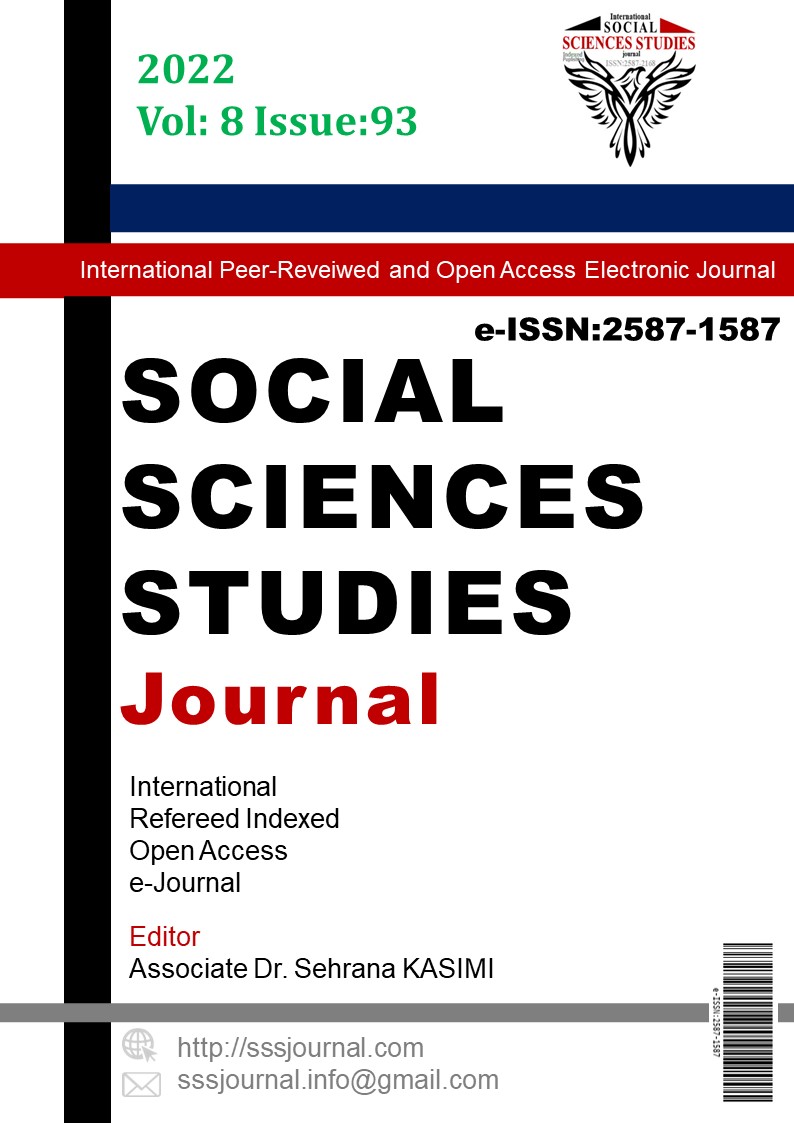Author :
Abstract
İnsanlığın var olmasından bu yana estetik kaygılarının karşılanması adına oluşan süsleme sanatının bir uzantısı olan işleme sanatı, insanoğlunun günlük yaşamında kullandığı giysilerde, ev eşyalarında, kullandığı araç ve gereçlerde yerini bulmaktadır. Çok eski bir tarihe sahip olan İşleme sanatı kültürlerin ve toplumların yaşantısına göre şekillenmekte, yapılan işlemeler bu değişkenlere bağlı olarak değişim göstermektedir. Türk kültürü için de oldukça önemli bir yere sahip olan Türk işleme sanatı, Orta Asya’dan başlayarak şuan da bulunduğumuz Türkiye Cumhuriyeti dönemine kadar varlığını sürdürmüştür. Orta Asya’da Türk işleme sanatında hayvan derileri ve bazı kumaş parçalarına hayvan motifleri ve insan figürleri işleyen Türkler, bu işlemeleri giysilerde, çadırlarda ve atların koşum takımlarında kullanmışlardır. Daha sonra İslam kültürünün içine giren Türkler bu kültürden her alanda etkilendiği gibi işleme sanatında da etkileri görülmüştür. Örneğin; insan ve hayvan figürlerinin kullanımı azalmış ve zamanla yok olmuştur. Bunun yerine daha çok gül ve benzeri çiçekler yerlerini almıştır. Türk işleme sanatı Selçuklu döneminde de gelişmeyi sürdürmüş daha sonraları Osmanlı dönemimde ise zirveyi görmüştür. Özellikle üst yönetici kısım ve saray etrafındakilerce sıkça kullanılan bu işlemeler oldukça önem görmekteydi. Osmanlı İmparatorluğu 19. yy’dan itibaren büyük bir gerileme dönemine girmiş, bu dönemde Batı devletlerinin yaptığı yenilenme çalışmalarını temel alarak ilerlemeyi düşünen Osmanlı İmparatorluğu, diğer alanlar dışında başlıca sanat ve toplum alanında Batı kültürünün etkisinde kalmıştır. Batı kültürünün ektisiyle bu dönemlerde Türk işleme sanatına birçok farklı teknik ve üsluplar katılmış, Türk işleme sanatını derinden etkilemiş ve değiştirmiştir. Bu çalışmada bu tekniklerin nereden geldiği ve tekniklerin detayları aktarılmıştır.
Keywords
Abstract
The art of embroidery, which is an extension of the art of ornamentation, which has been created to meet the aesthetic concerns of humanity since the existence of humanity, finds its place in the clothes, household goods, tools and equipment used by human beings in their daily life. Embroidery art, which has a very old history, is shaped according to the lives of cultures and societies, and the embroidery varies depending on these variables. Turkish embroidery art, which has a very important place for Turkish culture, has continued its existence starting from Central Asia until the period of the Republic of Turkey, where we are now. The Turks, who embroidered animal motifs and human figures on animal skins and some fabric pieces in Turkish embroidery art in Central Asia, used these embroidery on clothes, tents and horse harnesses. The Turks, who later entered the Islamic culture, were affected by this culture in every field, as well as in the art of embroidery. E.g; The use of human and animal figures declined and disappeared over time. Instead, more roses and similar flowers have taken their place. Turkish embroidery art continued to develop during the Seljuk period, and later reached its peak in the Ottoman period. These embroideries, which were frequently used by the people around the palace and especially the executive part, were of great importance. The Ottoman Empire entered a period of great decline since the 19th century, and the Ottoman Empire, which thought to progress on the basis of the renewal efforts of the Western states in this period, was under the influence of Western culture, mainly in the field of art and society, apart from other fields. With the influence of Western culture, many different techniques and styles were added to the Turkish embroidery art in these periods, deeply affecting and changing the Turkish embroidery art. In this study, where these techniques come from and the details of the techniques are given.
Keywords
- Altuntaş, Y. (1994). El Sanatlarının Dünü Bugünü ve Sorunları. Ankara: Türk Tarih Kurumu Basım Evi.
- Altuntaş, Y. (1994). El Sanatlarının Dünü Bugünü ve Sorunları. Ankara: Türk Tarih Kurumu Basım Evi.
- Anonim. (2015, Mart 13). Osmanlı Sanatında Batı Etkileri. 2021 tarihinde İstanbul Araştırmaları Enstitüsü: https://blog.iae.org.tr/sergiler/osmanli-sanatinda-bati-etkileri adresinden alındı
- Anonim. (2021). Brezilya Nakışı Örnekleri. 2021 tarihinde Yaratıcı Projeler3: http://yaraticiprojeler3.blogspot.com/2019/10/brezilya-naks-ornekleri-brazilian.html adresinden alındı
- Anonim. (2021). Florentine Bargello. 2021 tarihinde Glora Filia: https://glorafilia.com/product/florentine-bargello/ adresinden alındı
- Anonim. (2021). Goblen Nedir. 2021 tarihinde Goblenci: https://www.goblenci.com/goblen/goblen-nedir.htmlAnonim. (2021). Martin Winkler Teğel Baskılı Döşemelik Goblen. 2021 tarihinde Pinterest: https://tr.pinterest.com/pin/320248223494354980/ adresinden alındı
- Anonim. (2021). Rokoko. 2021 tarihinde Wikiland: https://www.wikiwand.com/tr/Rokoko adresinden alındı Barışta, H. (1995). Türk İşleme Sanatı Tarihi. Ankara: Gazi Üniversitesi İletişim Fakültesi Basımevi.
- Baskıcı, M. (2005). 1800 - 1914 Yıllarında Anadolu'da iktisadi Değişim . Ankara : Turhan.
- Evrenos, H. (2021). How to Acquire a Business Loan with Ease in Australia. 2021 tarihinde Pinterest: https://tr.pinterest.com/pin/763078730584639278/ adresinden alındı
- Papila, A. (2008). Osmanlı İmparatorluğu'nun Batılaşma Döneminde Resim Sanatının Ortaya Çıkışı ve Osmanlı Kimliğinin Resimsel Anlatımı. Sanat ve Tasarım Dergisi, 1(1), 117 - 134.
- Paşayeva, V., & Hamidova, Ü. (2003). Goblen'de Kullanılan Teknik Yöntemler. Atatürk Üniversitesi Güzel Sanatlar Fakültesi, 149 - 159.
- Saygın, Y. (2018, Şubat 10). Rokoko Sanatı Nedir? Özellikleri, Temsilcileri ve Tarihçesi. 2021 tarihinde Bilgi Hanem: https://bilgihanem.com/rokoko-sanati-nedir/ adresinden alındı
- Serkan, K. (2021). İslamiyet Öncesi Türk Resim Sanatı. 2021 tarihinde Unutulmuş Sanatlar: http://www.unutulmussanatlar.com/2013/09/islamiyet-oncesi-turk-resim-sanat_96.html adresinden alındı
- Sürür, A. (1976). Türk İşleme Sanatı. İstanbul: Ak Yayınları Türk Süsleme Sanatları Serisi: 4.
- Ekrem Hakkı Ayverdi, (1899-1984). https://blog.iae.org.tr/en/exhibitions/western-influence-on-ottoman-art https://tr.pinterest.com/cihanuzun67/h/
- https://www.needlenthread.com/2011/01/s-twist-vs-z-twist-embroidery-threads-stitched.html, https://tr.pinterest.com/amp/pin/361836151316223634/,
- https://hobby-choice.com/en/hobby/embroidery/page=dc20b9efcf2114fd0eb907ecbaabec35 Erişim https://ripplemark.wordpress.com/2016/04/24/bargello-work/
